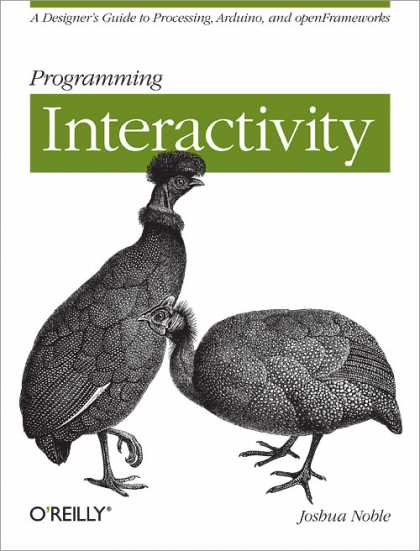Joshua Noble: Programming Interactivity: A Designer’s Guide to Processing, Arduino, and OpenFrameworks (2009)
Filed under manual | Tags: · arduino, human-computer interaction, interactivity, physical computing, processing

If you’re interested in using electronics and programming to create rich interactive experiences with your artwork, designs, or prototypes, “Programming Interactivity” is the place to start. You’ll explore common themes in interactive art and design, like 2D and 3D graphics, sound, physical interaction, computer vision, circuit bending, geo-location and more. This book explains programming and electrical engineering basics, and introduces three freely available tools created specifically for artists and designers:
- Processing, a Java-based programming language and environment for building projects on the desktop, Web, or mobile phones
- Arduino, a system that integrates a microcomputer prototyping board, IDE, and programming language for creating your own hardware and controls
- OpenFrameworks, a coding framework simplified for designers and artists, using the powerful C++ programming language
You’ll get working code samples you can use right away, along with the background and technical information you need to design, program, build, and troubleshoot your own projects. “Programming Interactivity” also examines cutting-edge design techniques, and includes discussions with leading artists and designers on projects and theory.
Publisher O’Reilly Media, Inc., 2009
ISBN 0596154143, 9780596154141
Length 768 pages
more info (gbooks)
programminginteractivity.com
preview
Tom Igoe: Making Things Talk: Practical Methods for Connecting Physical Objects (2007)
Filed under book, manual | Tags: · arduino, code, gps, hardware hacking, locative media, network art, physical computing, processing, rfid

Building electronic projects that interact with the physical world is good fun. But when devices that you’ve built start to talk to each other, things really start to get interesting. Through a series of simple projects, you’ll learn how to get your creations to communicate with one another by forming networks of smart devices that carry on conversations with you and your environment. Whether you need to plug some sensors in your home to the Internet or create a device that can interact wirelessly with other creations, Making Things Talk explains exactly what you need.
This book is perfect for people with little technical training but a lot of interest. Maybe you’re a science teacher who wants to show students how to monitor weather conditions at several locations at once, or a sculptor who wants to stage a room of choreographed mechanical sculptures. Making Things Talk demonstrates that once you figure out how objects communicate — whether they’re microcontroller-powered devices, email programs, or networked databases — you can get them to interact.
Each chapter in contains instructions on how to build working projects that help you do just that. You will:
* Make your pet’s bed send you email
* Make your own seesaw game controller that communicates over the Internet
* Learn how to use ZigBee and Bluetooth radios to transmit sensor data wirelessly
* Set up communication between microcontrollers, personal computers, and web servers using three easy-to-program, open source environments: Arduino/Wiring, Processing, and PHP.
* Write programs to send data across the Internet based on physical activity in your home, office, or backyard
* And much more
With a little electronics know-how, basic (not necessarily in BASIC) programming skills, a couple of inexpensive microcontroller kits and some network modules to make them communicate using Ethernet, ZigBee, and Bluetooth, you can get started on these projects right away. With Making Things Talk, the possibilities are practically endless.
Published by O’Reilly, 2007
ISBN 0596510519, 9780596510510
426 pages
Key terms:
serial port, Bluetooth, RFID, Digi-Key, ASCII, Mac OS X, Arduino, serial communication, telnet, ZigBee, personal computer, breadboard, HTTP, Ethernet, myFont, Linux, accelerometer, rssi, sensor, potentiometer
Review (we make money not art)
More info (publisher)
More info (google books)

